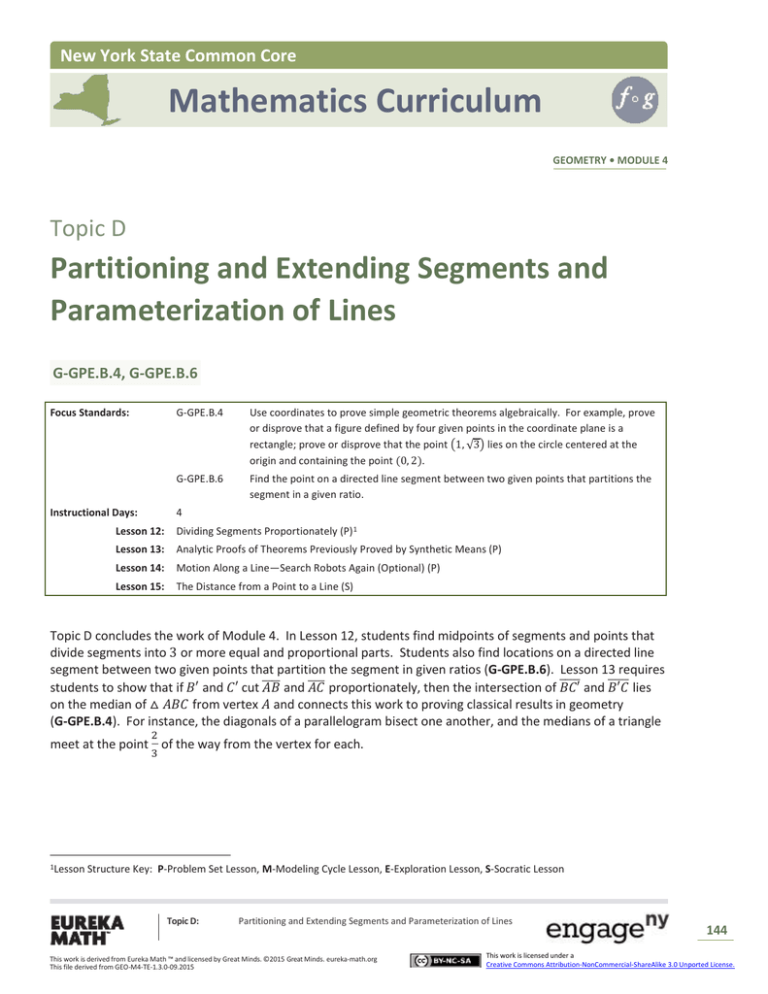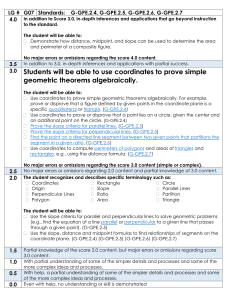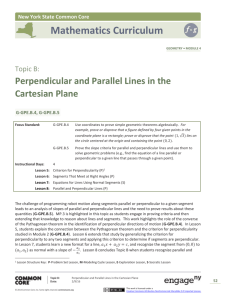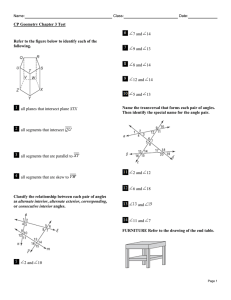Geometry Module 4, Topic D Overview
advertisement

New York State Common Core Mathematics Curriculum GEOMETRY • MODULE 4 Topic D Partitioning and Extending Segments and Parameterization of Lines G-GPE.B.4, G-GPE.B.6 Focus Standards: Instructional Days: G-GPE.B.4 Use coordinates to prove simple geometric theorems algebraically. For example, prove or disprove that a figure defined by four given points in the coordinate plane is a rectangle; prove or disprove that the point (1, √3) lies on the circle centered at the origin and containing the point (0, 2). G-GPE.B.6 Find the point on a directed line segment between two given points that partitions the segment in a given ratio. 4 Lesson 12: Dividing Segments Proportionately (P) 1 Lesson 13: Analytic Proofs of Theorems Previously Proved by Synthetic Means (P) Lesson 14: Motion Along a Line—Search Robots Again (Optional) (P) Lesson 15: The Distance from a Point to a Line (S) Topic D concludes the work of Module 4. In Lesson 12, students find midpoints of segments and points that divide segments into 3 or more equal and proportional parts. Students also find locations on a directed line segment between two given points that partition the segment in given ratios (G-GPE.B.6). Lesson 13 requires ̅̅̅̅̅ and 𝐵′𝐶 ̅̅̅̅̅ lies ̅̅̅̅ and 𝐴𝐶 ̅̅̅̅ proportionately, then the intersection of 𝐵𝐶′ students to show that if 𝐵′ and 𝐶′ cut 𝐴𝐵 on the median of △ 𝐴𝐵𝐶 from vertex 𝐴 and connects this work to proving classical results in geometry (G-GPE.B.4). For instance, the diagonals of a parallelogram bisect one another, and the medians of a triangle 2 meet at the point of the way from the vertex for each. 3 1Lesson Structure Key: P-Problem Set Lesson, M-Modeling Cycle Lesson, E-Exploration Lesson, S-Socratic Lesson Topic D: Partitioning and Extending Segments and Parameterization of Lines This work is derived from Eureka Math ™ and licensed by Great Minds. ©2015 Great Minds. eureka-math.org This file derived from GEO-M4-TE-1.3.0-09.2015 144 This work is licensed under a Creative Commons Attribution-NonCommercial-ShareAlike 3.0 Unported License. Topic D NYS COMMON CORE MATHEMATICS CURRICULUM M4 GEOMETRY Lesson 14 is an optional lesson that allows students to explore parametric equations and compare them with more familiar linear equations (G-GPE.B.6, G-MG.A.1). Parametric equations make both the 𝑥- and 𝑦-variables in an equation dependent on a third variable, usually time; for example, 𝑓(𝑡) = (𝑡, 2𝑡 − 1) represents a function, 𝑓, with both 𝑥- and 𝑦-coordinates dependent on the independent variable, 𝑡 (time). In this lesson, parametric equations model the robot’s horizontal and vertical motion over a period of time, 𝑡 𝑡 𝑃 = (20 + (100), 10 + (40)). 2 2 Introducing parametric equations in the Geometry course prepares students for higher-level courses and also represents an opportunity to show coherence between functions, algebra, and coordinate geometry. Students extend their knowledge of parallel and perpendicular lines to lines given parametrically. Students complete the work of this module in Lesson 15 by deriving and applying the distance formula (G-GPE.B.4) and with the challenge of locating the point along a line closest to a given point, again given as a robot challenge. Topic D: Partitioning and Extending Segments and Parameterization of Lines This work is derived from Eureka Math ™ and licensed by Great Minds. ©2015 Great Minds. eureka-math.org This file derived from GEO-M4-TE-1.3.0-09.2015 145 This work is licensed under a Creative Commons Attribution-NonCommercial-ShareAlike 3.0 Unported License.



